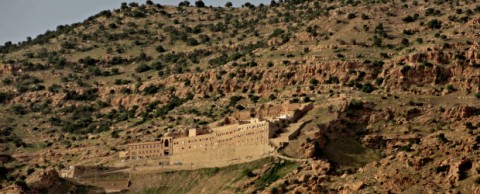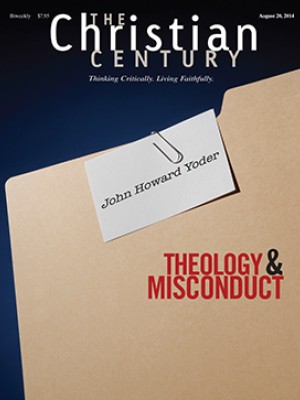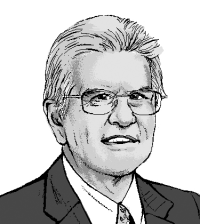Leaving Nineveh: The last days of Christians in Mosul
Three faiths esteem Jonah, whom God sent to the city now called Mosul.

The ancient Christian history of the Middle East has become agonizingly relevant. Cities central in that history appear in headlines in the context of fanaticism and mass destruction. The State Department’s maps of the latest atrocities coincide with the most venerable landscapes of Eastern Christianity.
The city of Damascus in Syria needs no explanation in terms of its role in the Christian story, and late Roman Gaza likewise produced some pivotal thinkers and theologians. Both cities are also featured in the Old Testament.
But what about Syria’s Hama, the scene of some of the bloodiest fighting in that country’s civil war? The Byzantines knew it as Epiphania, home of the historian John, who is a prime source for the Roman-Persian wars of the sixth century. Hama’s Great Mosque stands within the readily identifiable remains of the Byzantine basilica church.
Read our latest issue or browse back issues.
The first Syrian provincial capital to fall under rebel control in the current conflict was Ar-Raqqah, which historians of Christian monasticism know as Kallinikos, a haven of learning and piety from the sixth century. Latakia was once Laodicea, where the bishop was the often vilified heretic Apollinarius. Homs, another frequent Syrian battlefield, was fifth-century Emesa, where a beloved shrine claimed the head of St. John the Baptist.
Syria can scarcely compete historically, however, with neighboring Mesopotamia, the land we presently call Iraq (future maps might bear different names). Over the past summer, the city of Mosul has been the center of global attention, following its capture by the forces of the extremist Islamic State of Iraq and al-Sham. ISIS then went on to proclaim a revived caliphate, an office dormant since 1924, and promised to lead its followers against Christendom, even to the gates of Rome. It also launched a brutal reign of terror against both Shi‘a Muslims and fellow Sunnis. Before the new self-appointed caliph, Ibrahim, first addressed the Islamic world, his minions had murdered the city’s leading Sunni clerics. Although the so-called Islamic state may have stirred up too many enemies to prove an enduring presence, it naturally terrifies surviving members of other religions, especially Christians.
That story has been prominently reported, but few reports have paid much attention to the identity of those Christians and their spiritual culture which now seems on the verge of extinction. For Westerners, those local Christians face an easy choice: Why don’t they just leave? If they do, though, they will be abandoning a Mosul that in its day occupied a central place in Christian thought and development. Would Christians happily forsake Assisi or Santiago de Compostela, Canterbury or Cologne, if threatened with a similar situation? Would they not be held back by centuries of Christ-haunted memory and tradition? The story of Mosul is at least equal to that of any of these later upstarts.
Mosul was originally a center of the fearsome Assyrians, and that connection attracted the attention of Jews, Christians, and Muslims. All three faiths esteem the prophet Jonah, whom God sent to the Assyrian capital of Nineveh. Ancient Nineveh itself was once separate from Mosul but has now been absorbed into the metropolitan area that the region’s Christians call Nineveh rather than Mosul. Under its Arabic name of Nebi Yunus (Prophet Jonah), the prophet’s grave was a pilgrimage destination for millennia—although reports suggest that ISIS thugs are in the process of demolishing the shrine.
Mosul was an early center of Jewish life and learning, where a Christian church emerged no later than the second century. It became a key center for the Church of the East, the so-called Nestorian Church, which made it a metropolitan see. Also present were the so-called Monophysites, today’s Syrian Orthodox Church. These churches used Syriac, a language close to that of the apostles, and the Mosul area still has some Syriac-speaking villages.
Mosul was at the heart of a network of very early monasteries. Within 30 miles of the city are St. Elijah’s and St. Matthew (Mar Mattai), which date from the fourth century, Rabban Hormizd and Beth Abhe from the sixth or seventh, and many others: Mar Behnam, Mar Gewargis (St. George), Mar Mikhael (St. Michael). The greatest of these yielded nothing to such legendary houses as Monte Cassino or Iona. At its height, Mar Mattai was one of the greatest houses in the Christian world, with thousands of monks.
Around 850, Bishop Thomas of Marga described the lives of famous Syriac monks and holy men in his Book of Governor, which gives us a tantalizing picture of this lost spiritual world. Although his main interest was his own house of Beth Abhe, he mentions in passing dozens of small religious houses in the Mosul region, most of which we can no longer locate. The remains of many presumably survive under Iraqi village mosques.
The Church of the East that Thomas knew persisted for centuries, incredibly successfully considering it never enjoyed a close alliance with the secular state. Successively, the region was controlled by Zoroastrian Persians and by Muslim Arabs, but still the monasteries endured and flourished. In the histories of the 13th-century polymath Gregory Bar Hebraeus, the Mosul region appears as one of the hubs of the Christian universe. (Gregory himself was buried at Mar Mattai.)
Hard times arrived in the later 13th century with the coming of the Mongols. Facing growing intolerance in their old seat of Baghdad, the patriarchs of the Church of the East based themselves at the house of Rabban Hormizd. Christian life persisted there and in the surrounding religious houses. We get a sense of this from priceless Syriac Christian scriptures like the Cave of Treasures, which is preserved in the British Museum. It was copied in 1709 by the learned priest Homô, the son of the priest Daniel, who lived in Alqosh, near Mosul.
Mosul retained its Christian significance in the 16th and 17th centuries, when Western Catholics arrived to bring those ancient believers into submission to Rome. The missionaries enjoyed some success. The ancient Eastern Church was split into pro-Roman factions, known as the Chaldeans, and the sturdily independent resisters, the Assyrians. In the long term though, those once bitter divisions would not matter too much. Both groups still exist—on a sadly diminished scale.
The fall of Christian Mosul loomed in the beginning of the 20th century. Kurdish raids and bandit attacks repeatedly hit the monasteries and devastated their libraries. During World War I, the Ottoman Turks inflicted on local Christians the same attempted genocide they directed against the Armenians. By the 1920s, the once transcontinental Church of the East was reduced to about 40,000 survivors in the Mosul area. The church’s patriarch today is based in Chicago.
But even then Christians did not forsake Mosul. The population included Assyrians, Catholic Chaldeans, Syrian Orthodox, and Orthodox Arabs, who hoped to benefit from the state secularism promised by Saddam Hussein’s Ba’ath regime. If their ancient glories were long past, they hoped to remain unmolested in the land of the prophet Jonah and of the great patriarchs and abbots.
The Ba’ath regime was shaken by the 1991 Gulf War and then overthrown in the 2003 invasion led by the United States, which brought Islamist resistance to the fore. The ISIS campaign will presumably spell the end of a Christian presence.
We often read of the birth and growth of churches, very rarely of their deaths. In Mosul, however, we may be seeing the end of an astounding example of Christian continuity that lasted nearly two millennia.





